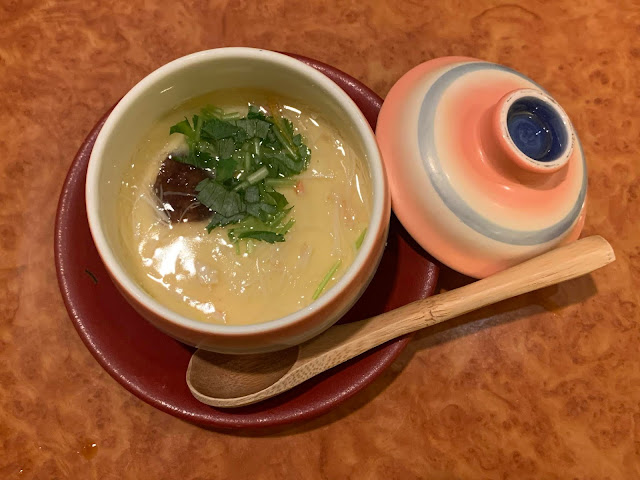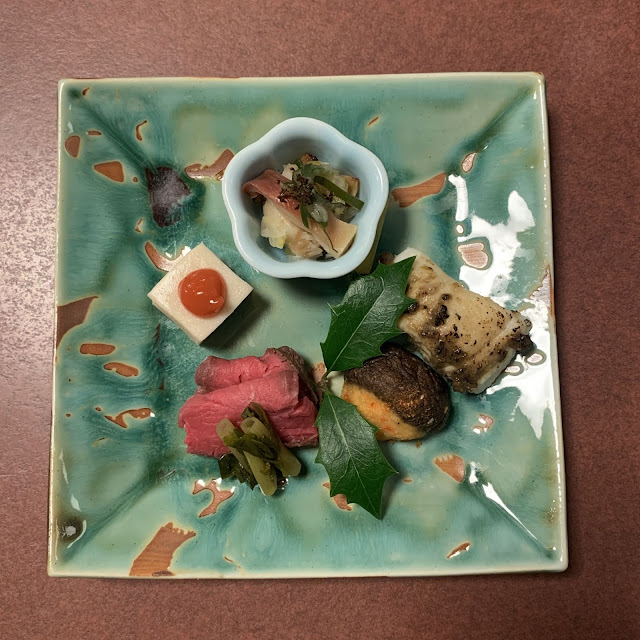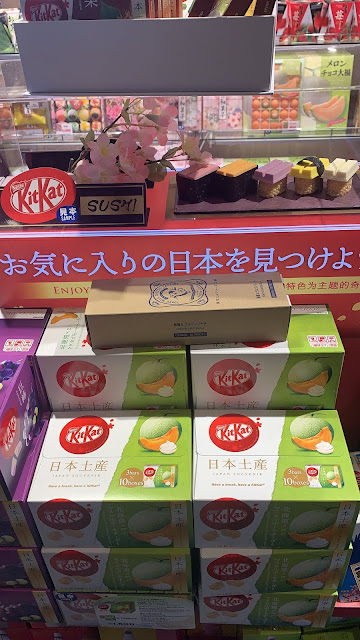Tokyo: Ghibli and Maneki-neko
After breakfast, we went to Gotokuji Temple. While it is famous for the grave of Sir Ii Naosuke (the chief Minister Tairo) of the Tokugawa Government from the late Edo period, this Zen temple is also a shrine for maneki-neko waving cats.
 |
| All the maneki-neko cat statues at the shine. |
This temple was the most remote one we went to. To get here, you travel through residential streets of the Setagaya ward in Tokyo. You turn down a narrow street, where the temple gates greet you.
 |
| Street leading up to the temple |
 |
| Temple gate as seen from the street |
Once inside, you walk down a long pathway.
 |
| Walking up toward the main hall |
No matter which way you turn, there was always something to look at. And, if you look closely, there are maneki-neko's everywhere you look... even in the details of the pagoda.
 |
| Pagoda at Gotokuji |
 |
| Maneki-neko on the pagoda |
Just past the pagoda, there is a pathway to turn left. There's a huge gate, and through the doorway on the right you'll find chōzubachi. Chōzubachi is where worshippers wash their left hand, right hand, mouth, and the handle of the water ladle to purify themselves before approaching the main Shinto shrine. You'll also find a stand with ema wishing plaques on which worshippers write their wishes.
 |
| Walking through a gate to another part of the temple |
 |
| Chōzubachi where people cleanse themselves before visiting the temple |
 |
| Ema wooden plaques hanging outside |
 |
| Close up of the ema plaques |
On the opposite side of the little courtyard is where you'll find the maneki-neko statues.
 |
| Looking towards the plaques and chōzubachi |
Legend has it that a long time ago, the temple was a shabby hut. The monk living here could barely live on the little income he gained as a practicing mendicant. He had a cat and cared for it like his own child... even sharing meals with it. One day, he told the cat, "If you are grateful to me, bring some fortune to the temple". After many months passed, the Monk heard sounds around the gate on a summer afternoon. At the gate, he saw five or six samurai warriors on their way from hawk hunting. They approached him and said "we were about to pass in front of your gate, but there was a cat crouching and suddenly it lifted one arm and started waving and waving when it saw us. We were surprised and intrigued and that brought us to come here to ask for some rest". The monk served tea and told them to relax when suddenly the sky darkened and heavy rain began to fall with thunder. While they waited for the sky to clear, the monk preached Sanze-inga-no-hou (past, present, future reasoning sermons). The samurai were delighted and began thinking about converting to the temple. One samurai announced that his name was Naotaka Ii, the king of Hikone in Koshu prefecture. Due to the cat's waving, he said they were able to hear the monk's preaching and it must have been Buddha's will. Soon after they returned home, he donated huge rice fields and crop lands to make the temple grand. Because of the cat, fortune was brought to the temple. Therefore, Gotokuji is called the cat temple. The monk later established the grave of the cat and blessed it. Before long, the statue of the cat was established so people could remember the past and worship it.
 |
| Looking down on the cats. All of them are different sizes! |
Everywhere you look, you'll find the maneki-neko waving cats!
 |
| There are thousands of cats everywhere you look. |
 |
| Taken from a low angle shooting upwards towards the forest. |
They're even stuffed into nooks and crannies.
 |
| The cats are places all over the temple. |
 |
| Close up of the cats. |
Today, everyone knows this temple as the symbol of household serenity, business prosperity, and fulfillment of wishes. As it is pretty remote, we were the only tourists here at 10am!
 |
| Another part of the temple with no people! |
From the cat temple, we made our way to Shirohige's Cream Puff Factory. That turned out to be a bit of an ordeal. As the weather was forecasted to rain pretty hard, all of the taxis in the area were taken. We ended up walking to a few blocks to a Lawson (a convenience store) where my mom asked (in Japanese) where we could catch a taxi. In the true spirit of Japanese hospitality, the clerk whipped out his cellphone and called a taxi company directly. In the meantime, he was on hold because the line was busy due to the upcoming storm so he walked outside with us and tried hailing taxis. After 10-15 minutes, he finally succeeded and we took a taxi to an even more remote location just for cream puffs. Thankfully, my mom still speaks enough Japanese and was able to ask the taxi driver to wait for us outside the cream puff factory. Otherwise, there is no way we'd get back to the hotel.
 |
| Menu and signage. |
A few years ago, Shirohige's Cream Puff Factory was a recommended video on Facebook. I just about died when I saw that I could eat Totoro cream puffs! The shop is run by the wife of Hayao Miyazaki's brother and for this reason, this bakery is the only shop in the world with official permission to make sweets with the shape of Totoro.
The two story shop is in a really residential area of Setagaya without any other stores or coffee shops nearby. I had read that the store sells out of cream puffs quickly but you can call to make a reservation for the cream puff flavors you want. We had our hotel call and when we arrived, our cream puffs were waiting for us in a neatly packed box! These cream puffs are made only once a day right before opening, and the cream itself is to die for.
While there is a seating area outside (where obviously you have to take a photo!!), we took our cream puffs back to the hotel. We purchased the year-round custard cream and the seasonal flavors strawberry and caramel banana. The strawberry is available from January to June and the caramel banana is available from January to March. If you go, check the website for the flavor chart!
The final verdict? All were delicious, but the strawberry one was my favorite.
Later in the day, I was getting hungry and I went to a fabulous hole in the wall ramen shop called Fukki, which was walking distance from our hotel. Fukki has only fewer than 10 counter seats with a walkway behind them so narrow that you have to walk sideways to get to the two tables in the back.
 |
| The outside of Fukki. |
They specialize in miso ramen... my favorite! You order from the ticket vending machine inside and hand over your ticket slip to the chef. In just a few minutes, your ramen is ready!
The ramen itself was almost too pretty to eat... With beansprouts, spinach, seaweed, meat, and perfectly cooked eggs, the presentation itself was mouth watering. But when I took my first spoonful of broth, I was in heaven. A bit thicker than what we are used to here, the miso ramen broth was not salty at all. Not only that, the noodles themselves were quite a bit thicker... not as thick as udon noodles, but definitely more thick than typical ramen noodles. By the time I was finished, I was already dreaming about ramen! We took a short walk around the hotel before heading back for some afternoon rest.
 |
| Walking around Tokyo. |
Later that evening we headed to Ginza, one of the city's top shopping districts specializing in high-tech electronics. Well, we didn't shop but we did go to eat. Last year our Japanese friends took us to Kani Doraku, a restaurant chain specializing in crustaceans (specifically crab). These restaurants are easily identifiable by the large, red crabs on the outside of each location. You can select dishes individually or from several set menus. We ended up ordering the same set menu as last year, though the dishes changed because we visited in a different season. Below is what we had...
We started off with cooked snow crab.
We then had crab sashimi consisting of snow crab and taraba (king) crab.
We had charcoal grilled crab (not pictured) followed by crab chawanmushi (a type of egg custard).
We had tempura crab with shiitake mushroom and shishito pepper.
We were also served crab sushi...
And a great clear soup with crab.
Of course, there was also dessert... black honey ice cream with a sesame cookie.
The following day, we had a very lazy day. The weather was the worst it has been on the entire trip. It was pouring all day long, it was super cold, and the wind was ridiculous. We only really walked to the convenience store to pick up some items for a picnic lunch! It was a perfect day to be lazy, though, as this was the one day we didn't have anything planned. And, because we had been sightseeing non-stop, we ended up needing the rest. The bad weather couldn't stop us from going out to dinner, though!
We went to Asakusa for dinner, a section of Tokyo with a vibe of an older Tokyo with traditional craft shops and street food stalls. I came across an article online that outlined 15 places to eat like a local in Tokyo. Curious, I clicked it. Prior to going to Japan, we knew we wanted to eat sukiyaki but didn't know where. Luckily, this article featured a sukiyaki restaurant called Asakusa Imahan which was founded in 1895 (though the Asakusa location was opened in 1913). Their exclusive Imahan wagyu beef are even sold in major department stores throughout Japan. When you sit down at the table, you're asked whether you'd like sukiyaki or shabu shabu style beef. As this restaurant is specifically known for their sukiyaki, of course that is what we had.
Our meal started off with a gorgeous plate of appetizers... (going clockwise from the white dish) salad with fish, anago (eel) sushi, shiitake mushroom with chopped shrimp ball, smoked beef, and tofu with plum sauce.
Then, the staff brought out a plate of marbled beef, raw egg which they whisk with chopsticks (this is used as the dipping sauce), and a plate of vegetables and noodles.
You cook everything on the grill at the table. The vegetables included cabbage, onion, mushrooms, shiitake mushrooms, and leafy greens plus tofu, pancake and noodles.
Later on in the meal, the staff brings rice, Japanese pickles, and miso soup with small mushrooms and tofu. This was by far, one of the best meals I have ever had!
The next day, we woke up early. If you've been following my blog for awhile, you'll remember I went to the Studio Ghibli museum in November 2018. Tickets are extremely hard to get. You either have to get them through Lawson months in advance, on Viator (but still you're not guaranteed tickets) or through a package with JTB (the largest travel corporation in Japan). In 2018, we had a Viator package which worked out but the museum was very crowded because we had a timed entry. With JTB, you can purchase a hotel package where you get a 2 night hotel stay plus Ghibli tickets which aren't time restricted. So, we headed to the museum before opening!!
The museum itself opens at 10am, but we ended up getting there closer to 9am... just like with LA, you can never be sure about Tokyo traffic!
To kill some time, we decided to walk around the museum and take some photos.
 |
| View of the Straw Hat cafe from outside the museum. |
By the time we had returned to the entrance, we were still so early that the gate leading to where the line officially starts wasn't even open yet!! AND, there were no other people waiting!
 |
| No line!!! |
We watched as the staff cleaned every inch of the outside of the museum. They watered the iron gate, cleaned the clock, wiped down the lights, climbed up the tower to raise the Studio Ghibli flag, and more.
At a little past 9:45am, they opened the iron gate and we walked right up to the museum entrance... We were the FIRST in line! Still, we had to wait 15 more minutes for the museum to open.
Being the first in line, I was able to get a great panorama of the museum...
 |
| Panorama of the museum. |
...and of all the people behind me! We asked a staff member how many people come to the museum daily and she said every day they sell out of tickets... admitting 600 people every hour for 8 hours each day.
While you can't take photos inside the museum, anything outside is fair game... like this little outdoor area by the lockers! For 100¥, you can store your belongings in a secured locker for your entire museum visit. Worth it for sure!
This time, we had a game plan. We decided we'd go to the gift shop first (which opened at 10:15am) because it was so crowded last time we were at the museum. In fact, it was so crowded that we couldn't even see all the items! This time, we did it perfectly. By the time the gift shop opened, there were only two other people upstairs. We took our time, and probably bought too much. From there, we headed downstairs to the Straw Hat Cafe (it opens at 11am) which we didn't get a chance to eat at last time because it had a 2 hour wait! This time, we got one of the last seats in the waiting area. Staff came around with a menu, letting us look it over. Awhile later, the staff came around again so we could place our order before we were seated. Once seated, the food came only a few minutes later! The whole experience was incredibly organized, making it that much more enjoyable.
The menu itself was small, but the food was fantastic. We both had the tonkatsu (breaded/fried pork) with Japanese curry and rice.
We also ordered the famous Straw Hat parfait which was a mix of ice cream, strawberries, kiwi, banana, cream, shortbread, and mango.
By the time we left, there was starting to be a long line outside the cafe.
From there, we decided to work our way from the top of the museum down. That meant going outside to see the giant robot from Castle in the Sky.
To get to the robot, you walk up a spiral staircase.
On the rooftop, there's a huge skylight where you can see one of the many beautiful stained glass windows if you crouch down low!
The main attraction, however, is the robot! This robot stands at nearly 17 feet tall and is the guardian of the Ghibli Museum.
From here, we could also see all the people entering the museum!
When you descend the stairs, you get to one of my favorite places to take a photo. The museum hands you souvenir tickets which are actual movie reels. I love holding these up to the light with the museum in the background!
Because it was still early, I took my time walking around the outside patios where you can take photos. I found this great Princess Mononoke mosaic...
The below patio was on the first floor of the museum near the information booth.
Outside by the lockers, there is this great little window too!
On the outside of the museum, there is even a Totoro ticket booth.
Now, for the goodies... the attention to detail in Japan is beyond incredible. At the museum, we bought gold coins in a Mamma Aiuto bag (Mamma Aiuto is the gift shop, named after characters from Porco Rosso).
I loved the gold foil stamping on the chocolates, but didn't expect the chocolates to be decorated!! All chocolates had the Ghibli museum crest on the backside. The front of the largest chocolate was the outside of the museum featuring the robot on the rooftop.
The other ones had Capo's face (the antagonist in Porco Rosso) and a close up of the Castle in the Sky robot.
My personal favorite was the soot sprites from my favorite Studio Ghibli movie, Spirited Away. This exact depiction also correlates to the outside of the museum, where the soot sprites appear under the Totoro ticket booth.
The real winner, however, is always the Ghibli Museum cookies. You can't get these tea cookies anywhere else, and they are to die for! The box comes with a variety including chocolate, Earl Grey tea, sesame, maple, and almond.
Of course, the cookies have characters and items from the movies too!
The largest cookie is the Ghibli museum crest in perfect detail.
Because I'm an artist, I love the stained glass in the Ghibli museum. Last year, I got a Totoro stained glass postcard. When you put it in the sunlight, it illuminates like it's real stained glass! This time, I got an even more detailed one (below).
After the Ghibli museum, we went back to Asakusa where we went to our favorite seven level matcha gelato shop. The line was so long that we didn't end up getting ice cream, but we did get some of my favorite tea to take back home! We then walked through Sensō-ji temple (which we visited on our last trip) and through all the shops on Nakamise street (the street leading up to the temple). Before we left, my mom had said she wanted to visit a fake food store for fun (in Japan, restaurants display fake food to show potential diners what the food looks like). We found a fun shop that had forks lifting spaghetti up in the air, ramen spilling over, and normal plates full of sushi and other food. Before we left, I had said I wanted to find a Totoro noren (a traditional Japanese fabric hung as a divider between rooms, in doorways, or in windows). As we were getting ready to hail a taxi at the end of Nakamise street, I saw a shop full of Studio Ghibli items! Sure enough "Aonoya" (the store) had Totoro norens. With our shopping checklist now checked off (minus one very important item that we later found in the airport), we hailed a taxi and returned to the sukiyaki restaurant... it was that good. Fortunately or unfortunately, the restaurant never has the same appetizer twice. On this night we had (clockwise from the top white dish) fish soup with mochi and uni, egg custard, beef sushi, carrot mousse, and salmon salad.
After dinner, we went back to the hotel to pack and prepare for the long journey home. In the morning, we ended up taking a quick walk to Zōjō-ji Temple. Only a few blocks away from our hotel, this is the head temple of the Jodo sect of Japanese Buddhism in the Kanto region. Many of the buildings are recent reconstructions except the main entrance gate which has survived many fires and earthquakes and dates back to 1622.
The temple was originally built in 1393 and moved to its present location in 1598 by Tokugawa Ieyasu who selected it as his family temple. The mausoleum of this family is at the back of the complex and contains the tombs of six of the Tokugawa shogun.
The Daiden (Hondo Main Hall) forms the core of the Buddhist structures of Zōjō-ji. It houses a large main image of Amida Buddha made during the Muromachi Period with an image of Great Teacher Shan-tao (who perfected China's Jodo Pure Land Buddhism) at its right and an image of Honen Shonon (who founded Japan's Jodo Shu) at its left. Behind the main hall, you can see Tokyo Tower which soars 1,092' above the ground.
All around the temple, you can find Jizo statues, child statues that are clothed and decorated. These statues represent the souls of unborn children. Jizo is the guardian of unborn, aborted, miscarried and stillborn babies. Here, people mourn the loss and also leave offerings for Jizobosatsu (the Buddhist protector of women and children) to assure the souls make it safely to the afterlife.
After walking around the temple grounds, we walked back to the hotel and headed to the airport. Finally at the airport, I spotted our final purchase... Japanese kit kats. As I mentioned last year, every city in Japan has different flavored kit kats. We grabbed our personal favorite, Hokkaido Melon, and away we went!
Thanks for reading about our time in Japan. Stay tuned for our upcoming Central Asia and Europe trip to Turkmenistan, Uzbekistan, Kyrgyzstan, Oman, Romania, and a few other great destinations! Be sure to hit the subscribe button on my homepage to be notified of new posts as internet can be unreliable. And, as always, follow my Instagram @elissatitle for more pics.




















































.jpg)








Comments
Post a Comment